
Vajrayāna, also known as Mantrayāna, Mantranāya, Guhyamantrayāna, Tantrayāna, Tantric Buddhism, and Esoteric Buddhism, is a Buddhist tradition of tantric practice that developed in the Indian subcontinent and spread to Tibet, Nepal, other Himalayan states, East Asia, and Mongolia.
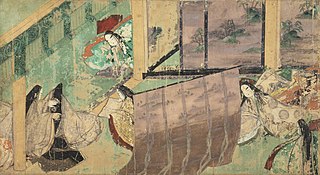
The Heian period is the last division of classical Japanese history, running from 794 to 1185. It followed the Nara period, beginning when the 50th emperor, Emperor Kammu, moved the capital of Japan to Heian-kyō. Heian (平安) means "peace" in Japanese. It is a period in Japanese history when the Chinese influences were in decline and the national culture matured. The Heian period is also considered the peak of the Japanese imperial court, noted for its art, especially poetry and literature. Two types of Japanese script emerged, including katakana, a phonetic script which was abbreviated into hiragana, both unique syllabaries distinctive to Japan. This gave rise to Japan's famous vernacular literature, with many of its texts written by court women who were not as educated in Chinese as their male counterparts.

The Japanese missions to Imperial China were diplomatic embassies which were intermittently sent to the Chinese imperial court. Any distinction amongst diplomatic envoys sent from the Japanese court or from any of the Japanese shogunates was lost or rendered moot when the ambassador was received in the Chinese capital.
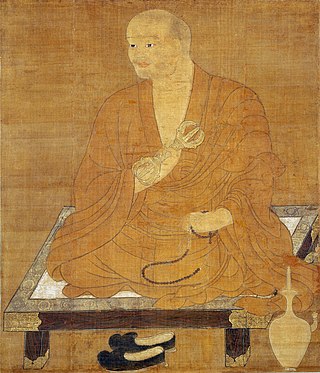
Kūkai, born Saeki no Mao, posthumously called Kōbō Daishi, was a Japanese Buddhist monk, calligrapher, and poet who founded the esoteric Shingon school of Buddhism. He travelled to China, where he studied Tangmi under the monk Huiguo. Upon returning to Japan, he founded Shingon—the Japanese branch of Vajrayana Buddhism. With the blessing of several Emperors, Kūkai was able to preach Shingon teachings and found Shingon temples. Like other influential monks, Kūkai oversaw public works and constructions. Mount Kōya was chosen by him as a holy site, and he spent his later years there until his death in 835 C.E.

Tendai, also known as the Tendai Lotus School, is a Mahāyāna Buddhist tradition officially established in Japan in 806 by the Japanese monk Saichō. The Tendai school, which has been based on Mount Hiei since its inception, rose to prominence during the Heian period (794–1185). It gradually eclipsed the powerful Hossō school and competed with the rival Shingon school to become the most influential sect at the Imperial court.

Buddhism in Japan was first established in the 6th century CE, derived from Chinese Buddhism. Most of the Japanese Buddhists belong to new schools of Buddhism which were established in the Kamakura period (1185-1333). During the Edo (Tokugawa)-period (1603–1868), Buddhism was controlled by the feudal Shogunate. The Meiji-period (1868–1931) saw a strong response against Buddhism, with persecution and a forced separation between Buddhism and Shinto.
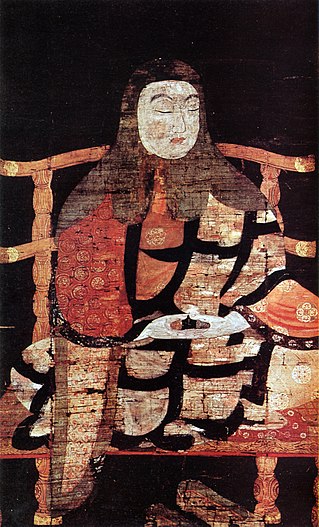
Saichō was a Japanese Buddhist monk credited with founding the Tendai school of Buddhism based on the Chinese Tiantai school he was exposed to during his trip to Tang China beginning in 804. He founded the temple and headquarters of Tendai at Enryaku-ji on Mount Hiei near Kyoto. He is also said to have been the first to bring tea to Japan. After his death, he was awarded the posthumous title of Dengyō Daishi (伝教大師).
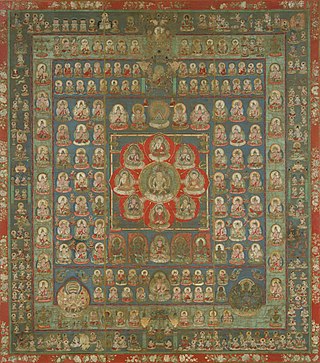
In Vajrayana Buddhism, the Womb Realm is the metaphysical space inhabited by the Five Compassion Buddhas. The Womb Realm is based on the Mahavairocana Tantra. The name of the mandala derives from chapter 2 of the sutra, where it is said that the buddha Mahāvairocana revealed the mandala's secret teachings to his disciple Vajrasattva from his "womb of compassion". In other translations, the term Matrix Realm or Matrix Mandala is used.

Mikkyō, also known as Himitsu Bukkyo, is a Japanese term for the Vajrayana practices found throughout Japanese Buddhism. Mikkyō rituals and practices are found in many Japanese Buddhist schools, including Shingon, Tendai, Kegon, Hossō and Zen. There are also similar esoteric teachings found in the syncretic religion of Shugendō and may also be practiced in independent lineages of holy men (hiriji) and also Japanese New Religions.

The schools of Buddhism are the various institutional and doctrinal divisions of Buddhism that have existed from ancient times up to the present. The classification and nature of various doctrinal, philosophical or cultural facets of the schools of Buddhism is vague and has been interpreted in many different ways, often due to the sheer number of different sects, subsects, movements, etc. that have made up or currently make up the whole of Buddhist traditions. The sectarian and conceptual divisions of Buddhist thought are part of the modern framework of Buddhist studies, as well as comparative religion in Asia.

Honzon, sometimes referred to as a Gohonzon, is the enshrined main image or principal deity in Japanese Buddhism. The buddha, bodhisattva, or mandala image is located in either a temple or a household butsudan.
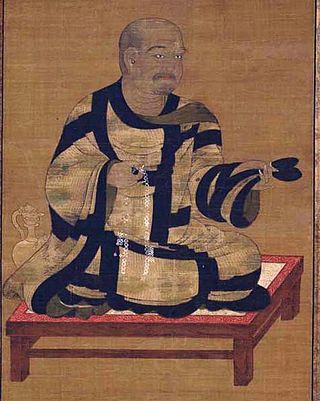
Vajrabodhi was an Indian esoteric Buddhist monk and teacher in Tang China. He is one of the eight patriarchs in Shingon Buddhism. He is notable for introducing Vajrayana Buddhism in the territories of the Srivijaya Empire which subsequently evolved into a distinct form known as Indonesian Esoteric Buddhism.

Buddhism's rich history spans over 2,500 years, originating from the Indian subcontinent in the 2nd century AD. Teachings of the Buddha were introduced over time, as a response to brahmanical teachings. Buddhism relies on the continual analysis of the self, rather than being defined by a ritualistic system, or singular set of beliefs. The intersections of Buddhism with other Eastern religions, such as Taoism, Shinto, Hinduism, and Bon illustrate the interconnected ideologies that interplay along the path of enlightenment. Buddhism and eastern religions tend to share the world-view that all sentient beings are subject to a cycle of rebirth that has no clear end.
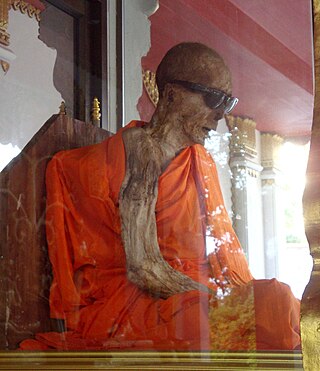
Sokushinbutsu are a type of Buddhist mummy. In Japan the term refers to the practice of Buddhist monks observing asceticism to the point of death and entering mummification while alive. Although mummified monks are seen in a number of Buddhist countries, especially in South Asia where monks are mummified after dying of natural causes, it is only in Japan that monks are believed to have induced their own death by starvation.

Abhisheka is a religious rite or method of prayer in which a devotee pours a liquid offering on an image or murti of a deity. This is common to religions such as Hinduism, Buddhism and Jainism.

Huiguo (746–805) was a Buddhist monk of Tang China who studied and taught Chinese Esoteric Buddhism, a Vajrayana tradition recently imported from India. Later Huiguo would become the teacher of Kūkai, founder of Shingon Buddhism, a prominent school of Buddhism in Japan.

The Tachikawa-ryū (立川流) was a branch of Shingon Buddhism founded in the early 12th century by Ninkan, a monk of the Daigo-ji lineage of Shingon who was exiled in 1113 to the province of Izu after being implicated in a plot to assassinate the then reigning emperor of Japan, Emperor Toba.
The Six Schools of Nara Buddhism, also known as the Rokushū 六宗, were academic Buddhist sects. These schools came to Japan from Korea and China during the late 6th and early 7th centuries. All of these schools were controlled by the newly formed Japanese government of Nara. These schools were installed to mimic and expand upon already existing mainland Asian Buddhist thought.

Chinese Esoteric Buddhism refers to traditions of Tantra and Esoteric Buddhism that have flourished among the Chinese people. The Tantric masters Śubhakarasiṃha, Vajrabodhi and Amoghavajra, established the Esoteric Buddhist Zhenyan tradition from 716 to 720 during the reign of Emperor Xuanzong of Tang. It employed mandalas, mantras, mudras, abhiṣekas, and deity yoga. The Zhenyan tradition was transported to Japan as Shingon Buddhism by Kūkai as well as influencing Korean Buddhism and Vietnamese Buddhism. The Song dynasty (960–1279) saw a second diffusion of Esoteric texts. Esoteric Buddhist practices continued to have an influence into the late imperial period and Tibetan Buddhism was also influential during the Yuan dynasty period and beyond. In the Ming dynasty (1368–1644) through to the modern period, esoteric practices and teachings became absorbed and merged with the other Chinese Buddhist traditions to a large extent.

Mountain worship is a faith that regards mountains as sacred objects of worship.























